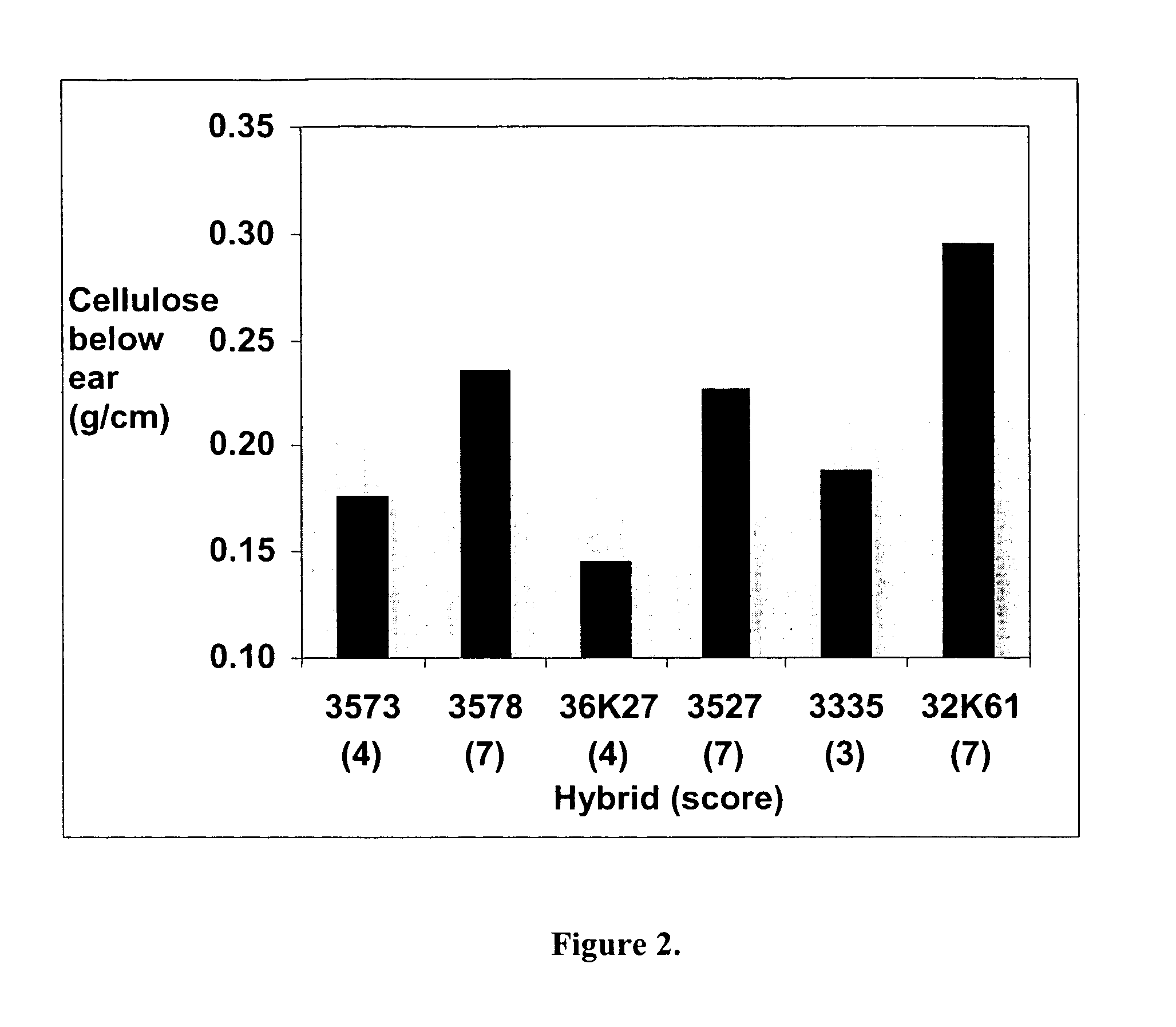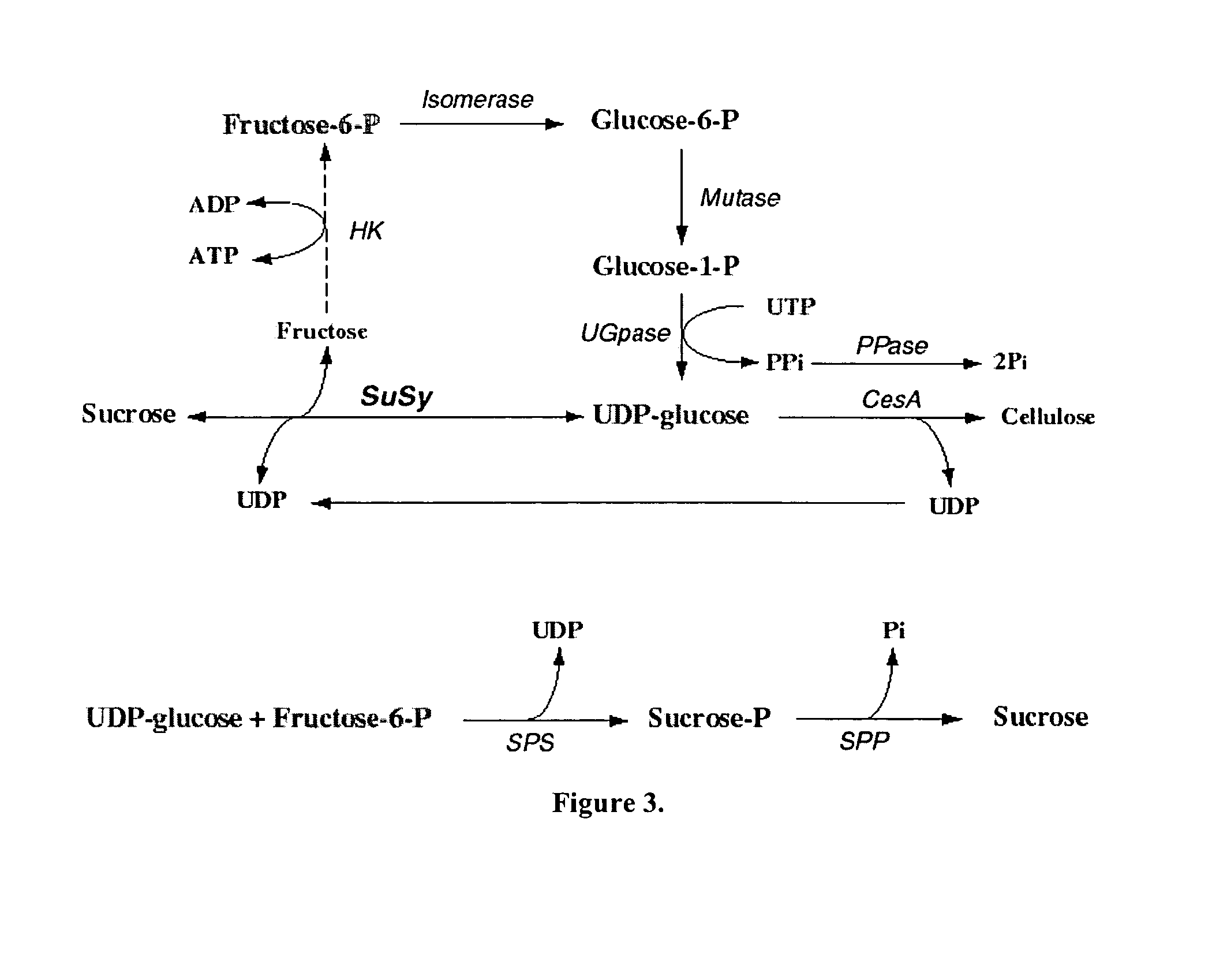Isolated sucrose sythase polynucleotides and uses thereof
a technology of sucrose sythase and polynucleotides, which is applied in the field of plant molecular biology, can solve the problems of significant yield loss, achieve the effects of improving grain quality and/or plant stalk quality, improving stalk quality and/or stalk strength, and reducing the number of sythase sythase sythase sythase sythase sytha
- Summary
- Abstract
- Description
- Claims
- Application Information
AI Technical Summary
Benefits of technology
Problems solved by technology
Method used
Image
Examples
example 1
[0182]This example describes the construction of a cDNA library.
[0183]Total RNA can be isolated from maize tissues with TRIzol Reagent (Life Technology Inc. Gaithersburg, Md.) using a modification of the guanidine isothiocyanate / acid-phenol procedure described by Chomczynski and Sacchi (Chomczynski, P., and Sacchi, N. Anal. Biochem. 162, 156 (1987)). In brief, plant tissue samples are pulverized in liquid nitrogen before the addition of the TRizol Reagent, and then further homogenized with a mortar and pestle. Addition of chloroform followed by centrifugation is conducted for separation of an aqueous phase and an organic phase. The total RNA is recovered by precipitation with isopropyl alcohol from the aqueous phase.
[0184]The selection of poly(A)+ RNA from total RNA can be performed using PolyATtract® system (Promega Corporation. Madison, Wis.). Biotinylated oligo(dT) primers are used to hybridize to the 3′ poly(A) tails on mRNA. The hybrids are captured using streptavidin coupled t...
example 2
[0187]This method describes construction of a full-length enriched cDNA library.
[0188]An enriched full-length cDNA library can be constructed using one of two variations of the method of Carninci et al. Genomics 37: 327–336, 1996. These variations are based on chemical introduction of a biotin group into the diol residue of the 5′ cap structure of eukaryotic mRNA to select full-length first strand cDNA. The selection occurs by trapping the biotin residue at the cap sites using streptavidin-coated magnetic beads followed by RNase I treatment to eliminate incompletely synthesized cDNAs. Second strand cDNA is synthesized using established procedures such as those provided in Life Technologies' (Rockville, Md.) “SuperScript Plasmid System for cDNA Synthesis and Plasmid Cloning” kit. Libraries made by this method have been shown to contain 50% to 70% full-length cDNAs.
[0189]The first strand synthesis methods are detailed below. An asterisk denotes that the reagent was obtained from Life ...
example 3
[0231]This example describes cDNA sequencing and library subtraction.
[0232]Individual colonies can be picked and DNA prepared either by PCR with M13 forward primers and M13 reverse primers, or by plasmid isolation. cDNA clones can be sequenced using M13 reverse primers.
[0233]cDNA libraries are plated out on 22×22 cm2 agar plate at density of about 3,000 colonies per plate. The plates are incubated in a 37° C. incubator for 12–24 hours. Colonies are picked into 384-well plates by a robot colony picker, Q-bot (GENETIX Limited). These plates are incubated overnight at 37° C. Once sufficient colonies are picked, they are pinned onto 22×22 cm2 nylon membranes using Q-bot. Each membrane holds 9,216 or 36,864 colonies. These membranes are placed onto an agar plate with an appropriate antibiotic. The plates are incubated at 37° C. overnight.
[0234]After colonies are recovered on the second day, these filters are placed on filter paper prewetted with denaturing solution for four minutes, then...
PUM
| Property | Measurement | Unit |
|---|---|---|
| Temperature | aaaaa | aaaaa |
| Temperature | aaaaa | aaaaa |
| Temperature | aaaaa | aaaaa |
Abstract
Description
Claims
Application Information
 Login to View More
Login to View More - R&D
- Intellectual Property
- Life Sciences
- Materials
- Tech Scout
- Unparalleled Data Quality
- Higher Quality Content
- 60% Fewer Hallucinations
Browse by: Latest US Patents, China's latest patents, Technical Efficacy Thesaurus, Application Domain, Technology Topic, Popular Technical Reports.
© 2025 PatSnap. All rights reserved.Legal|Privacy policy|Modern Slavery Act Transparency Statement|Sitemap|About US| Contact US: help@patsnap.com



